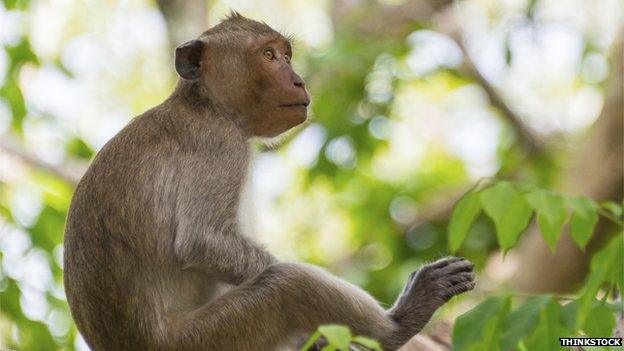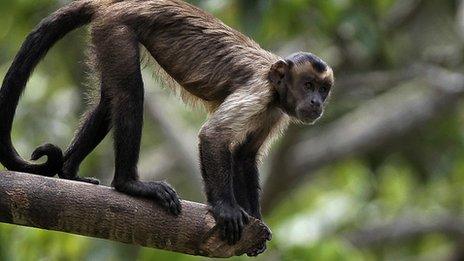Baboons may share human ability to build on work of others
- Published

Scientists gave baboons a series of grid patterns to remember and copy in a computer test
Researchers have shown that the essential elements of the capacity of humans to build on the work of others may also be present in baboons.
The phenomenon, known as cumulative culture, sees people make gradual improvements in knowledge over time.
A team of scientists from Edinburgh and CNRS Aix Marseille universities created computer tests for a group of baboons.
The tests suggested that primates could make gradual improvements to the work of others.
Baboons had free access to computer booths. The team created a series of grid patterns which the primates tried to remember and copy by pressing buttons on a computer screen.
Each baboon had a set of 50 grids to complete. Whether or not they were correct, the patterns that one baboon produced became the patterns the next baboon in a chain had to memorise and reproduce.
This was an attempt by the scientists to recreate the kind of cultural exchange of knowledge and skills that takes place in humans.
Crucial differences
Baboons who were not involved in the current round of transmission were exposed to randomly generated tests.
The social transmission was indirect: the behaviour of previous baboons in the chain was passed through computers and touch screens rather than direct observation by the following baboon in the chain.
This kind of "indirect social learning" often takes place in human behaviour, such as through books or the internet.
The researchers found, when patterns are transmitted between baboons, they changed to become easier to memorise and pass on, as more tetronimos - geometric shapes comprised of four connected squares - emerged.
The higher instance of tetronimos was caused by baboons earlier in the chain making mistakes. However, as baboons saw more tetronimo shapes, their ability to reproduce them improved. The ultimate result was that the set of grids evolved to become easier for future baboons in the chain.
Dr Kenny Smith, of the University of Edinburgh's School of Philosophy, Psychology and Language Sciences, likened this behaviour to the way languages evolve, which is also driven by the accumulation of unintentional error.
His colleague Prof Simon Kirby said: "For a long time, researchers thought that cumulative culture was uniquely human. However, the evolution we see in our experiment mirrors human cumulative culture, providing an entirely new way of studying our species-defining trait."
Dr Nicolas Claidiere, of CNRS Aix Marseille University, said: "Baboons do not have complex culture in the wild, but appear to be capable of much more in our experimental set-up. Understanding why this is gets us closer to uncovering the crucial differences between humans and our primate relatives."
- Published6 March 2013
